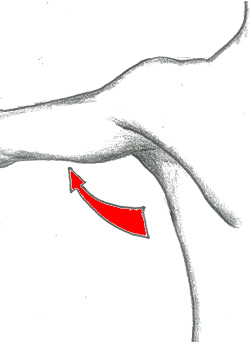| 4.8 ) Movements at the shoulder joint |
|
 This consists of movements of the pectoral girdle and thos of the limb This consists of movements of the pectoral girdle and thos of the limb |
|
|
| Flexion |
|
 |
 Forward and slightly medial movement of the arm – is produced by : Forward and slightly medial movement of the arm – is produced by :
- Pectoralis major
- Deltoid (the anterior fibres),
- Biceps brachii
|
|
| Extension |
|
 |
 The opposite movement – is produced by: The opposite movement – is produced by:
- Latissimus dorsi,
- Teres major and minor,
- Deltoid (the posterior fibres),
- Infraspinatus
- Long head of triceps brachii
|
|
| Abduction |
|
 |
 Elevation away from the side of the body in the plane of the scapula – produced by: Elevation away from the side of the body in the plane of the scapula – produced by:
 The initial 15° is caused by supraspinatus, 15-90° by deltoid , 90-180° requires lateral rotation of scapula to point glenoid cavity upwards therefore The initial 15° is caused by supraspinatus, 15-90° by deltoid , 90-180° requires lateral rotation of scapula to point glenoid cavity upwards therefore
- Serratus anterior
- Trapezius contributes.
|
|
| Adduction |
|
 |
 Produced mainly by gravity, while the adductor muscles are relaxed. Adduction against resistance is produced by Produced mainly by gravity, while the adductor muscles are relaxed. Adduction against resistance is produced by
- Subscapularis
- Pectoralis major
- Teres major and minor
- Latissimus dorsi
- Coracobrachialis
- Long head of triceps
|
|
| Lateral rotation |
|
 |
 The front of the arm turning laterally – is produced by: The front of the arm turning laterally – is produced by:
- Infraspinatus,
- Teres minor
- Posterior fibres of deltoid
|
|
| Medial rotation |
|
 |
 Produced by: Produced by:
- Pectoralis major,
- Anterior fibres of deltoid
- Subscapularis
- Latissimus dorsi
- Teres major
|
|
| Peculiarities |
|
Most striking peculiarities in this joint are:
- The large size of the head of the humerus in comparison with the depth of the glenoid cavity, even when this latter is supplemented by the glenoidal labrum.
- The looseness of the capsule of the joint.
- The intimate connection of the capsule with the muscles attached to the head of the humerus.
- The peculiar relation of the tendon of the long head of the Biceps brachii to the joint.
|
| |





